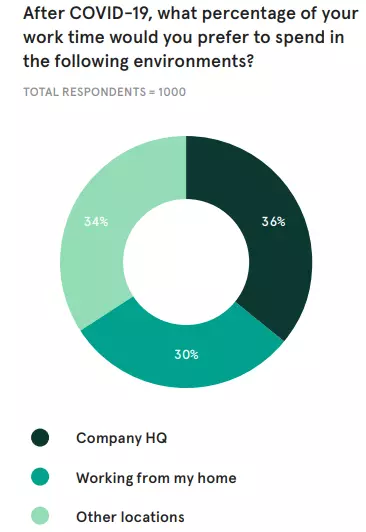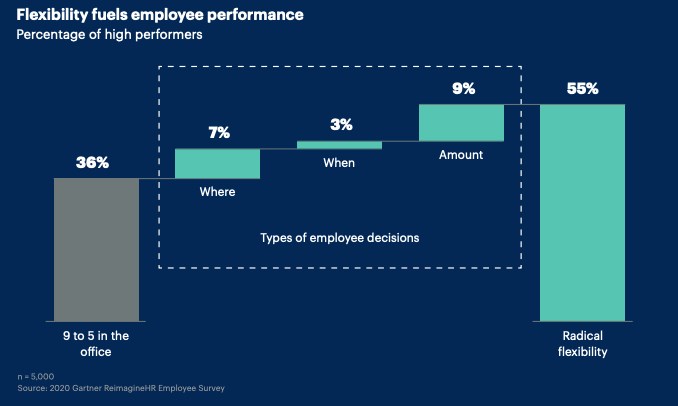Hybrid Work is the Future - 6 Ways to Help You Decide if It’s Right for Your Company
Is hybrid work the future? A lot of experts, employers, and employees think so. Read on for six ways to help you decide.
“Hybrid work is here to stay.”
“It’s the new 9-5.”
“Employees now prefer working from home.”
Do these headlines sound familiar? They should.
As the world starts to come out of its COVID-19 hibernation, companies are adjusting to a new normal: hybrid working. One study found 49% of employees don't want to stay remote or return full-time to the office. Instead, they would prefer a hybrid model.
And there are lots of reasons why.

Employees are concerned about missing out on career advancement opportunities due to a lack of visibility from full-time remote work. Some are worried their relationships with coworkers could suffer without seeing them in person. But a majority still don't want to go back to their desks full-time because they love the flexibility that hybrid offers.
Mega-corporations like UBS, Citigroup, and Apple are already testing out a hybrid work model that allows employees to work some of the time remotely. But it isn't just for Enterprise companies, which is why any business should consider if hybrid work is the way forward for them.
Thinking of making the jump to hybrid work? Here are six things to consider.
1. Have you crunched the numbers?
Going hybrid doesn’t happen overnight.
Organizations need to crunch their numbers and see if their team is ready to go hybrid. They need to consider how employees will feel about the change, and how long it’ll take to get the right policies in place for a smooth transition. As Mark Mortensen wrote in Harvard Business Review, this happens in three stages:
📈 Data collection: Ask your team and company stakeholders what their priorities would be if you moved to a hybrid model. You should do it independently and anonymously to get honest answers from everybody. Then, gather all of the responses and use them to start building a foundation about what your hybrid future could look like
👀 Visualizing the future: Your team will have different priorities when going hybrid, so get each member to visualize what their ideal future at work looks like. Create a list of priorities that your team can vote on to see what the majority envision your hybrid model to look like
✔️ Making data-based decisions: Once you've collected enough data from your team, use it to make decisions about what your hybrid model will be. For example, some team members may want to focus on culture, while others believe random interactions will be essential to making hybrid work successful. Use these data nuggets to build a hybrid model that fits your team's goals
Your goal isn't to agree on what your hybrid model will look like. It's to get a clear idea about what your team cares about using cold, hard data. Mortensen says whatever the results are, it's important to negotiate the trade-offs, so everyone is happy.
“Sometimes, resolution will naturally result from a discussion about the data. However, other times, the relationships are more complex and the decision-making process is subject to biases, so don’t hesitate to employ a more structured approach,” he says.
2. Can you offer a space other than home or office?
Hybrid work strategies should allow employees more than just the option to work at home or in the office.
Encouraging your team to work in different environments, like co-working spaces, gives them a change of scenery. One study with WeWork found that the most satisfied employees want to spend more time in a “third space” that isn’t the office or their home.

And some companies are getting more creative and offering options outside of co-working spaces.
SaaS company Kissflow launched a mixed working model called REMOTE+ in response to the COVID-19 pandemic.

The model offers employees a chance to work anywhere for three weeks of the month while spending the remaining week working in the office. Kissflow covers accommodation costs for the office week so its team isn’t out of pocket.
Experts say even with hybrid models, businesses should consider changing up their office environment. Anita Williams Woolley researches organizational behaviour and theory at Carnegie Mellon University and says companies should reevaluate their offices for their team’s needs.
"If anything, I'd keep the conference room, maybe get rid of some of the cubicles that nobody likes anyway, and invest in the private workspaces for the people that need to be in the office,” she says.
3. Are you ready to give up (some) control?
When the global workforce locked down and started working from home, something peculiar happened. We got more work done.
Studies found that when employees were given the flexibility to choose where, when and how much they worked, they went above and beyond. This flexibility fueled a new group of high performers.

This is another decision your company has to make: what’s actually most important to you? Do you need your team to spend a set amount of time in front of their screens, or are outcomes more important?
Gartner recommends tracking success in two ways: workforce outcomes and business outcomes.
🧑💼 Workforce outcomes: Track your team’s outcomes and how well they reach goals and collaborate together. Having a culture of trust and accountability is more important for hybrid teams because the mental and physical well-being of employees is the key to successfully transitioning to this way of work
🏢 Business outcomes: Hybrid models can reduce overhead costs and give businesses the chance to find high-quality, diverse candidates no matter where they’re located
If you're willing to give up the control that comes with having your team in the office five days a week, the benefits of hybrid work can be huge.
4. Can you make sure employees are treated equally?
Hybrid work environments bring a new problem for companies: what if some employees want to work full-time in the office, and some only occasionally?
Without a plan to bridge the gap between workers at home and those in the office, your team members working remotely can start to feel left out. One study also found workers at home:
❌ Were less than half as likely to be promoted
❌ Missed out on bonuses – 38% didn’t get one
❌ Put in an average of six unpaid hours of overtime a week because they couldn’t switch off
This inequality can also impact how you collaborate if it's not addressed. It's easy for team members in the office to meet for quick chats and brainstorming sessions, but the rest of your employees can't do that from home. This can create a divide and make the people working remotely on any given day feel like they're missing out.
The key to resolving this, according to experts at Maastricht and Erasmus University, is recognizing what work should stay at the office, and what can be done at home. Researchers found simple tasks are better suited to home environments, where it's quiet and there are fewer distractions. But for "high stakes" tasks like writing a legal contract or designing a new building – your team is better off working together in the office.
5. Do you have the resources and structure to go hybrid?
Making sure a hybrid work model is successful takes commitment and investment.
First, you need to make sure your team has enough resources and equipment to work from home when they want to. But you'll also need to have the managerial structure in place, so your team feels supported. This means:
👩💻 Productivity without micromanagement: Hybrid workplaces won’t thrive with micromanagement. By switching to weekly one-on-one meetings to discuss goals and expectations, you can demonstrate that you trust your team to do their job while they're working from home instead of constantly messaging them.
🏗️ Continuing to build skill sets: Just because your team isn't in the office with you doesn't mean you stop building up their skill set. Hybrid models require companies to think outside the box to develop soft skills and make sure their team can adapt to change and collaborate remotely.
✔️ Get consistent: Even if half your team is in the office, you should lock in certain “consistencies” to make sure your hybrid model lasts. For example, once you move to a hybrid workplace, schedule every meeting to happen over video. The same goes for project planning –do it using collaboration tools instead of physical whiteboards. This allows you to work at the same level and pace no matter where your team is.
6. Do you have the tech to be successful?
It's all very well saying you're going to make all your meetings virtual so that everyone can be involved. But do you have to technology required to run successful hybrid meetings? Historically this involved buying a fancy conference room system, or else sharing a laptop in a meeting room or heading off to separate booths, defeating the whole point of some people being in the office! With Whereby's Co-location Groups feature, running a hybrid meeting is much simpler. Everyone can use their own laptop in the same room, with microphones on. There's no annoying echo issues and a much more inclusive experience for your remote team too.
Of course, all of this is only possible if you’re willing to invest in the right resources that make hybrid work … well, work. Equipping employees with tools to collaborate, hold effective hybrid video meetings, and talk to each other helps them remain flexible and engaged in their work.
A tool like Whereby can bridge the gap and give hybrid teams a space to communicate easily and equally. They don't have to download software or an app – just create a custom URL link for a meeting, and the rest of your team can join in one click. There, you can brainstorm, run workshops, and chat – all in one place.


